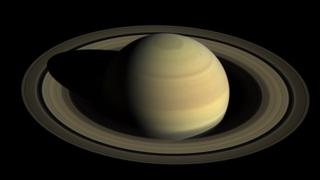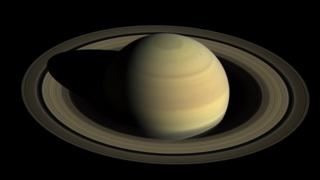Saturn overtakes Jupiter as planet with most moons
Jupiter had been the “moon king” for about 20 years. …

 Image copyright NASA/JPL-Caltech/Space Science Institute
Image copyright NASA/JPL-Caltech/Space Science Institute Saturn has overtaken Jupiter as the planet with the most moons, according to US researchers.
A team discovered a haul of 20 new moons orbiting the ringed planet, bringing its total to 82; Jupiter, by contrast, has 79 natural satellites.
The moons were discovered using the Subaru telescope on Maunakea, Hawaii.
Each of the newly discovered moons in orbit around Saturn is about 5km (three miles) in diameter; 17 of them orbit the planet “backwards”.
This is known as a retrograde direction. The other three moons orbit in a prograde direction – the same direction as Saturn rotates.
Two of the prograde moons take about two years to travel once around the ringed planet.
The more-distant retrograde moons and one of the prograde moons are further out, each taking more than three years to complete an orbit.
“Studying the orbits of these moons can reveal their origins, as well as information about the conditions surrounding Saturn at the time of its formation,” said Dr Scott Sheppard, from the Carnegie Institution for Science in Washington DC, who led the team.
The outer moons appear to be grouped into three distinct clusters based on the inclinations of the angles at which they orbit the planet.
“This kind of grouping of outer moons is also seen around Jupiter, indicating violent collisions occurred between moons in the saturnian system or with outside objects such as passing asteroids or comets,” said Dr Sheppard.
One of the newly discovered retrograde moons is the furthest known moon around Saturn.
The retrograde and prograde moons may have once been part of at least three larger bodies that were broken apart in the distant past. This may have occurred through collisions with other moons or with passing comets.
“Using some of the largest telescopes in the world, we are now completing the inventory of small moons around the giant planets,” said Dr Sheppard. “They play a crucial role in helping us determine how our Solar System’s planets formed and evolved.”
Dr Sheppard told BBC News that Jupiter had been the planet with most known moons since the late 1990s.
The observing team that discovered the new moons using the Subaru telescope included Dr Sheppard, David Jewitt of University of California, Los Angeles (UCLA), and Jan Kleyna of the University of Hawaii.
The team has initiated a contest to name the moons. They have to be named after giants from Norse, Gallic or Inuit mythology, corresponding to the three different clusters.
Follow Paul on Twitter.


